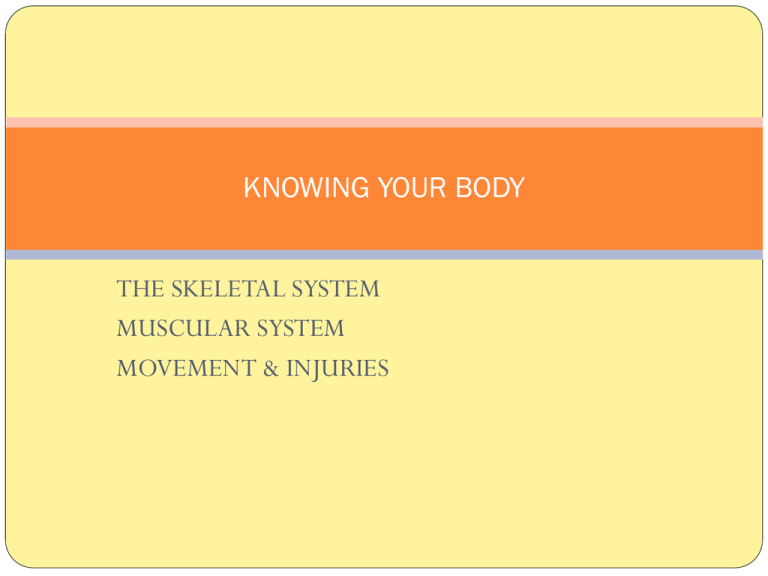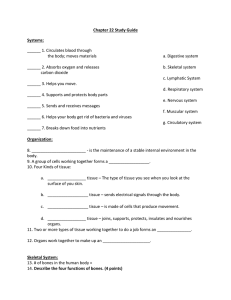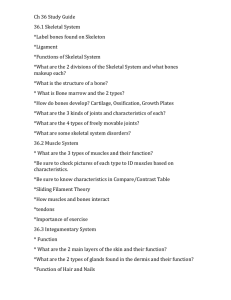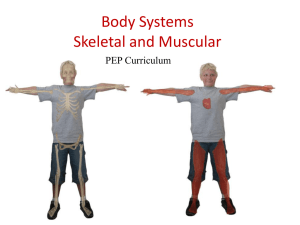knowing your body
advertisement

KNOWING YOUR BODY THE SKELETAL SYSTEM MUSCULAR SYSTEM MOVEMENT & INJURIES PARTICIPATING IN PHYSICAL ACTIVITY THE PURPOSE OF THE SKELETAL SYSTEM Protection Support Blood cell Formation Storage Leverage Question: Are bones living? THE SKELETAL SYSTEM UPPER BODY Skull Clavicle Sternum Scapula Humerus Ribs Vertebral Colum Radius Ulna Carpals Metacarpals Phalanges THE SKELETAL SYSTEM LOWER BODY Pelvic Girdle Femur Patella Tibia Fibula Tarsals Metatarsals Phalanges THE PURPOSE OF THE MUSCULAR SYSTEM Movement Strength Heat absorption Shaping of body Maintain Posture Question: Are there different types of muscles? TYPE OF MUSCLES A. Smooth Muscles B. Cardiac Muscle C. Skeletal Muscles THE MUSCULAR SYSTEM Trapezius Deltoid Pectoralis Major Triceps Biceps Latissimus Dorsi Abdominals Gluteus Maximus Quadriceps Hamstrings Gastronemius COMMON INJURIES 1. Strain a. Definition b. Symptoms c. Causes 2. Sprain a. Definition b. Symptoms c. Causes 3. Treatment----P.R.I.C.E. COMMON INJURIES Strain - pull or even a tear that implies damage to the muscle. Symptoms – are swelling, pain, weakness in the muscle, unable to use the muscle, and tender to the touch. Causes – direct blow, over-extension, overuse, and lifting or pulling too much weight, and/or trauma. COMMON INJURIES Sprain – undue stress and/or trauma to ligaments, tendons, cartilage and other supportive tissues. Symptoms – rapid swelling, pain, and unable to move normally. Causes- injury to ligaments and etc. are caused by being stretched beyond their normal capacity. OTHER COMMON INJURIES Dislocation: A dislocation occurs when extreme force is put on a ligament, allowing the ends of two connected bones to separate. Fractures: a medical condition in which there is a break in the continuity of the bone. ... P.R.I.C.E. TREATMENT PROTECTION REST ICE COMPRESSION ELEVATE BODY FACTS OTHER TERMS Ligaments - Fibrous tissue that connects bones to other bones. Tendons - a tough band of fibrous connective tissue that usually connects muscle to bone and is capable of withstanding tension. Cartilage - A tough, elastic, fibrous connective tissue found on the ends of bones in a joint area, also found in you ears. REVIEW OF BODY FACTS Adults have 206 bones in the body. Newborns have 300 plus bones that later fuse together. Bones are living. There are several types of muscles in the body. The heart muscle is called a cardiac muscle. The body has over 600 muscles in the body. Muscles are classified as voluntary or involuntary. EVALUATION & TREATMENT An x-ray can help rule out a fracture or other bone injury. Magnetic resonance imaging (MRI) can help determine muscle, tendon, ligament, joint injuries. P.R.I.C.E. Surgery Medications-muscle relaxer, ibuprophen, anti-inflammatory. Use of devices – boot, crutches, cast, sling, brace and others FITNESS FOR LIFE LETS GET FIT REVIEW FOR TEST BONES: Skull Clavicle Sternum Scapula Humerus Ribs Vertebral Colum Radius Ulna Carpals Metacarpals Phalanges Pelvic Girdle Femur Patella Tibia Fibula Tarsals Metatarsals Phalanges REVIEW MUSCLES: Trapezius Deltoid Pectoralis Major Triceps Biceps Latissimus Dorsi Abdominals Gluteus Maximus Quadriceps Hamstrings Gastronemius Know the purpose the skeletal and muscular system. Know the facts of the bones & muscles. Know the common injuries and basic treatments.







